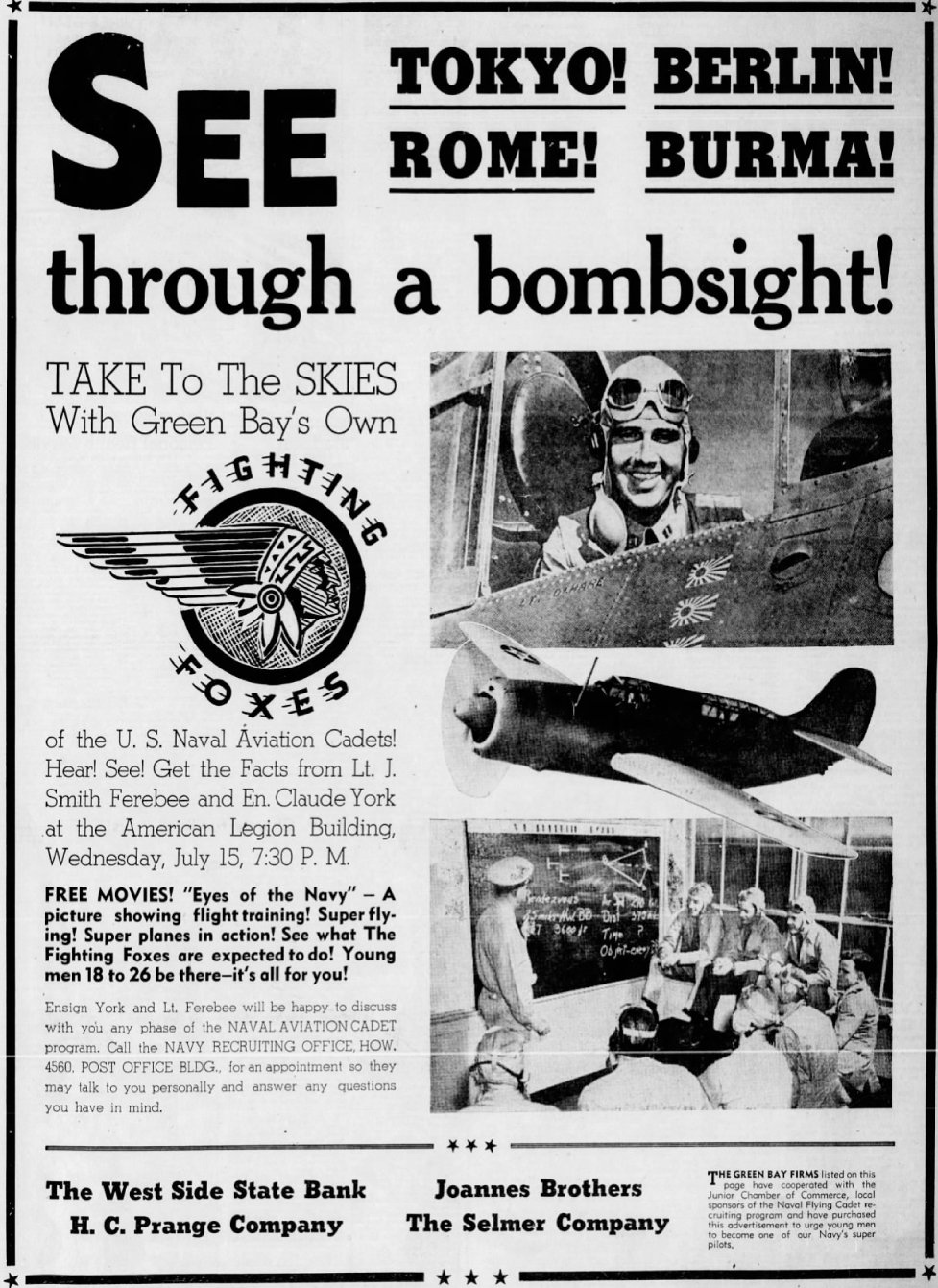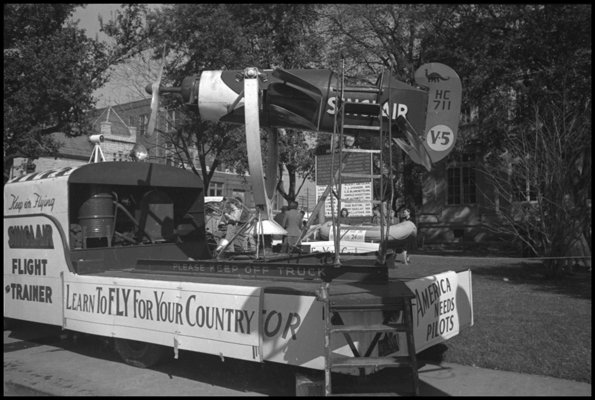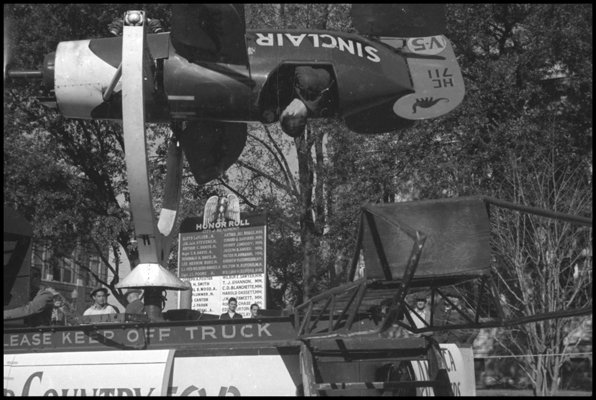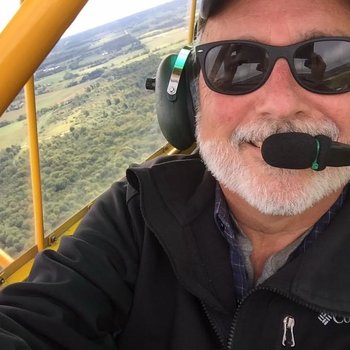
Military recruitment during times of war is, historically, local by nature. This was the norm even before we became a country. City leaders or prominent citizens volunteered to form a unit of which they would then become commander. This was common from the Revolutionary War through the Spanish American War.
The US Navy was in dire need of pilots and pilot candidates in the months leading up to the outbreak of World War II. The Civilian Pilot Training Program (CPTP), begun in 1939, helped but proved to be too late. In the early months of 1942 Wisconsin communities began local recruitment efforts to form squadrons of naval aviation recruits.
Lieutenant J. Smith Ferebee, representing the Chicago Naval Air Cadet Selection Board in Chicago, told the Green Bay Press Gazette on May 16, 1942, that there are several reasons to recruit in squadrons. He said, “Most important is that the training is so rigorous that it is necessary for a man to have friends to help him where he is weak.”
The Junior Chamber of Commerce organizations from nine cities - Appleton, Fond du Lac, Green Bay, Kewaunee, Manitowoc, Neenah, Oshkosh, Sheboygan, and Two Rivers sponsored such a squadron. Cadets were recruited from beyond the sponsoring cities to include Clintonville, Menasha, Omro, Seymour, Sturgeon Bay, Winneconne, and other locations. The local Naval Aviation Cadet Selection Board in Chicago worked with the JCCs in their efforts.
A contest to name the new squadron concluded in late May. Suggestions from throughout the region were received. Some of the more interesting were: “Twentieth Century Rough Riders”, “MacArthur’s Flying Eagles”, “Winnebago Wings” and “The Flying Comets”. MacArthur was mentioned in several suggestions, no doubt a reflection of the then current hostilities in the Philippines.
According to an article in the May 25 edition of the Appleton Post Crescent, Miss Ruth Mary Nowack won the naming contest with her suggestion of “Fighting Foxes”. Miss Nowack was a 15-year-old sophomore at Oshkosh High School. She had three cousins serving in the military. Her submission included the following justification: “I suggest that the Fox River squadron be named ‘Fighting Foxes’ in honor of the Indian tribe which lived in the river valley and after whom our beautiful river is named. Those first Americans of the Fox tribe were known far and wide among other Indian tribes as ferocious, courageous, fighting warriors.”
A contest to design a squadron insignia began on June 1 and ran for eight days. According to the Sheboygan Press, “Drawings may be in pencil, ink, crayon, or watercolor. The winning insignia, which is to bear the name ‘Fighting Foxes’, is to be used as the design for gold pins and for inscriptions on banners, posters, etc.” On June 19, it was announced that Gilbert H. Krueger of Neenah won the insignia design contest. Krueger was the art director for Tuttle Press Company in Appleton.
The city with the highest number of recruits of the nine sponsoring cities would act as host of the induction ceremony. The nearly daily newspaper articles ran like a sport scoreboard listing each recruit’s name, their hometown and where they enlisted. Almost every article included a reminder that males between the ages of 18 and 27 should consider joining the Fighting Foxes. All area newspapers ran full page ads that looked much like recruitment posters.
A July 8, 1942, Green Bay Press Gazette article reads, “The official count of the number of naval aviation recruits enlisted for the ‘Fighting Foxes’ the Fox valley river air squadron being formed in nine cities, shows Green Bay leading the list with 12 enlistments. The official standings in the race to supply the greatest number of recruits were released this morning by the naval aviation cadet selection board in Chicago.
The total number of enlistments received so far is 34, and Green Bay has the lion’s share. Oshkosh follows with 7, Fond du Lac with 6, Appleton with 3, Manitowoc and Sheboygan with 2, Kewaunee and Two Rivers with one, and Neenah with none.”
During the third week of July all area newspapers reported that a Link Trainer would be visiting the region during August. Factually, it was the Sinclair Flight Trainer that would visit. Sponsored by the Sinclair Oil Company, the trainer was very successful in boosting recruitment. The trainer was a small-scale mockup of a single-seat airplane mounted on gimbals. The trainer’s flight controls would move the “aircraft” through all three axis of flight.
A statewide, two-month naval cadet drive entitled “Fly For Navy” began on August 1, 1942 and continued through the end of September. Governor Julius P. Heil provided his full endorsement with this statement: “Though Wisconsin is already a forerunner in the number of young men given to naval aviation, it is eager to establish an even greater record. Therefore in the name of the state, I readily endorse the new August and September drive for cadets and pledge its fullest cooperation in the ‘Fly For Navy’ month’s campaign.”
The official end of the recruitment effort was September 1, with a total of 65 cadet recruits. Final standings for the recruitment contest were: Green Bay, 17; Oshkosh, 16; Appleton, 10; Fond du Lac, 8; Sheboygan, 5; Kewaunee, 3; Manitowoc, 3; Neenah, 2; Two Rivers, 1. There were numerous applicants waiting for confirmation of their acceptance into the Navy, so the actual numbers increased. Other applicants applied after the contest ended so the Fighting Foxes cadet squadron grew even into October.
The Fighting Foxes were inducted as a group in Green Bay on Sunday, September 27 during half-time of the Packers-Bears game. Before the ceremony, Lieutenant Commander Carl G. Olson told the Oshkosh Northwestern, “This is one of the best campaigns of this sort we have ever had, and every participating city in the Fox River valley and the northern lakeshore region is to be congratulated on the swell job that has been done.”
The ceremony, while not equal to the half-time pageantry of today’s NFL games, certainly had its share of patriotism. The soon to be naval cadets were seated behind the Chicago bench during the first half. Two inductees – Art Albrecht and Tony Canadeo were on the Packers bench—they were Packers players! As the first half ended, the nearly 100 inductees left the stands and formed a parade led by Navy and Marine color guards onto the playing field. Then Lt. Commander Olsen provided opening remarks. Winners of the name and insignia contests – Ruth Mary Nowack, Oshkosh, and Gilbert H. Krueger of Neenah, were named honorary squadron members. Lieutenant J. Smith Ferebee then administered the Navy oath of service.
After successfully completing the selection process the new aviation cadet would then enter flight training via the Civilian Pilot Training Program (CPTP). The training would then move to the University of Iowa for three months of ground training. This was followed by preliminary flight training at NAS Glenview just north of Chicago. Secondary training was completed at either NAS Pensacola, Jacksonville, Corpus Christi, or San Diego.
The Fighting Foxes were just one of at least 10 Naval cadet squadrons that sprang up across Wisconsin in the early months of 1942. The Fighting Foxes recruited from the Fox River valley and the northern lakeshore. The Wisconsin Valley Thunderbirds recruited from Marshfield, Wisconsin Rapids, Stevens Point, and northward. There were two Flying Tornadoes squadrons recruited from the Milwaukee area. The Flying Badgers, with cadets coming primarily from the University of Wisconsin, had an amazing six squadrons.
Do you have a WWII Navy pilot in your family? Were they a member of any of these cadet squadrons? We would like to learn their story. Email me at the address below.
I want to thank Ensign William Jakeman for his research assistance for this article and locating images of the Sinclair Flight Trainer. Ensign Jakeman is awaiting assignment to flight school. He currently serves as a Research Section Volunteer at the Emil Buehler Naval Aviation Library in the National Naval Aviation Museum at NAS Pensacola. Good luck in your flight training and your naval career Ensign Jakeman!
Image citation for Sinclair Flight Trainer images:
Fisher, Larry Jene. [Photograph of Sinclair Flight Trainer], photograph, 1942~; (https://texashistory.unt.edu/ark:/67531/metapth587352/m1/1/?q=Sinclair%20Flight%20Trainer: accessed February 6, 2024), University of North Texas Libraries, The Portal to Texas History, https://texashistory.unt.edu; crediting Lamar University.
Fisher, Larry Jene. [Photograph of Sinclair Flight Trainer], photograph, 1942~; (https://texashistory.unt.edu/ark:/67531/metapth587524/m1/1/?q=Sinclair%20Flight%20Trainer: accessed February 6, 2024), University of North Texas Libraries, The Portal to Texas History, https://texashistory.unt.edu; crediting Lamar University.


